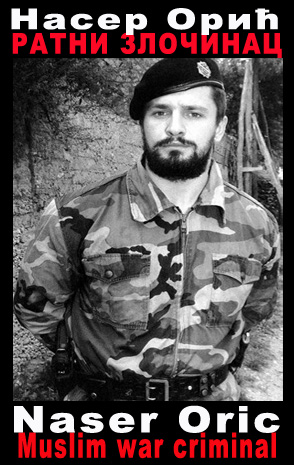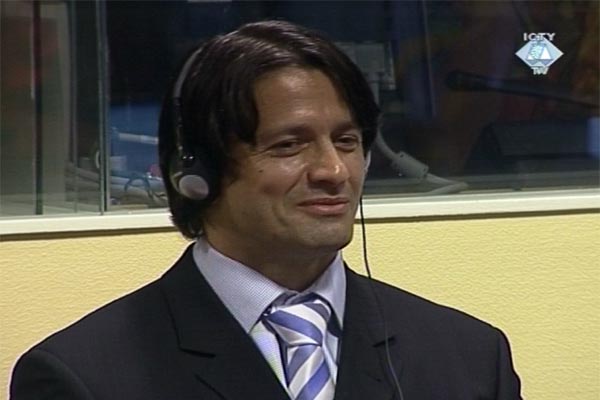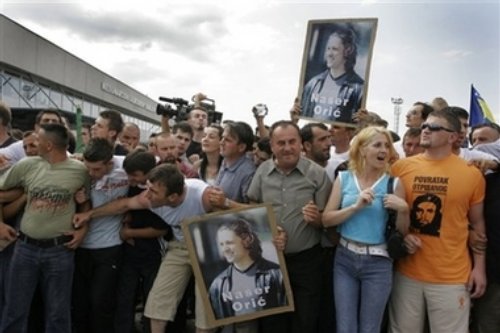|
|
Period:
Yugoslav Wars
Region:
Bosnia and Herzegovina
The Muslim war criminal Naser Orić - Bosnia 1992
Naser Orić (1967) was the commander of the so-called Muslim units of the Army of Bosnia and Herzegovina on the territory of Srebrenica during the Bosnian Herzegovinian war in the early 1990s.
During 1992-1995, he took part in massacres of Serbs and ethnic cleansing of Serb villages in eastern Bosnia in the area of Srebrenica. The most notorious massacres are those committed on St. Peter's Day 1992 and Christmas 1993 in the village Kravica, near Bratunac.

The Hague tribunal set a precedent in 2008 when it acquitted him of war crimes in Bosnia and Herzegovina in the 1990s, which was a mockery of justice and victims.
Today, Naser Orić lives freely in Sarajevo, where he enjoys the status of a national hero among Muslims.
CURRICULUM VITAE
Naser Orić from father Džemal and mother Hata was born on March 3, 1967, in the village of Potočari near Srebrenica in eastern Bosnia and Herzegovina. He has one brother, Nedžad. During his compulsory military service during 1985-1986, he was a member of the special units of the Yugoslav People's Army for Atomic and Chemical Defense. He left the JNA with the rank of corporal.
He married twice, the first time to his girlfriend Zahid, a year younger than him and with whom he has two children: a daughter Scheherazade and a son Amar. After his divorce from Zahid, he found a younger wife, Amra Alajbegović, whom he married.
In 1988, after completing a six-month police course in Zemun, and worked at the Savski Venac police station in Belgrade as an intern. As a member of the police unit for special actions, he had training for another two years. In 1990, Naser Orić was transferred to Kosovo and Metohija, for a year, as a member of the special operations units of the Ministry of the Interior of the Republic of Serbia, where he worked on the suppression of Albanian terrorists.
Upon his return to Belgrade, he joined the State Security Service when he became the bodyguard (guardian) of Slobodan Milosevic, then President of the Socialist Republic of Serbia. During the demonstrations on March 9, 1991, in Belgrade, Naser Orić took part in the arrest of Vuk Drašković (opposition leader). At night, he worked at the entrance to the famous Belgrade disco in Knez Mihajlova Street.
With the break-up of the former Yugoslavia in 1991-1992 and the outbreak of war in the western parts of the SFRY in the summer of 1991, Naser Orić decided to return to Bosnia, and on August 5, 1991, he started working at the Ilidža police station on the outskirts of Sarajevo. At the end of 1991, he was transferred to the Srebrenica police station and on April 8, 1992, he was promoted to chief of the Potočari police station.
After the Bosnian Herzegovinian war, he went to Tuzla where he dealt with crime, extortion, drug distribution, and robbery of rich citizens, also involved his close relatives in these activities.
WAR CRIMES
After the outbreak of the armed conflict in Bosnia and Herzegovina, Naser Orić was appointed Commander of the Territorial Defense Staff in Srebrenica on May 20, 1992, and from July 1, 1992, a member of the so-called Wartime presidency of Srebrenica.
At the beginning of November 1992, he was appointed Commander of the United Armed Forces of the Srebrenica subregion, and in addition to the territory of the municipality of Srebrenica, the territories of the municipalities of Bratunac, Vlasenica, and Zvornik were assigned to his authority. On January 1, 1994, these armed forces were renamed the "Headquarters of the Eighth Operational Group Srebrenica".

Naser in the village of Kravica 1993
Naser Orić led numerous attacks on more than 50 Serb villages in 1992-1993 in the municipalities of Bratunac and Srebrenica. His units are responsible for the deaths of more than 3,800 Serbs in eastern Bosnia.
On St. Peter's Day 1992, Naser Orić and his units came to the Srebrenica village of Zalazje, where they committed massacre of Serb civilians. At least 69 Serb residents were killed on that occasion. Naser Orić came on horseback, carrying a green (Arabic flag), shouting: "Catch the living Chetniks! Don't leave the cats either." They threw Serbs into the basement, and then threw burning tires at them so that everyone burned alive: Gojko Petrović, Dragan Rakič, Luka Jeremić, Marko Jeremić, and Radovan Jeremić, while Dragomir Vujadinović, Petko Simić, Branko Simić, Miladin Tubić, Ivan Cvjetinović, Momčilo Rakić, Milisav Ilić were taken to the city of Srebrenica. Naser Orić personally slaughtered Judge Slobodan Ilić.
The following month, on August 8, 1992, Orić led hordes of criminals who attacked the Srebrenica villages of Ježeštica, Šljikovići, and Zalužje. On that occasion, they killed 13 local Serbs and looted Serbian property.
In mid-December 1992, members of the Muslim so-called BiH Army, led by Naser Orić continued their bloody campaigns in Srebrenica villages. Then, on December 14, 1992, they attacked the Serbian villages of Bjelovac, Sikiric, and Loznicka Rijeka. On that occasion, about 180 Serbs were killed, and at least 350 houses were burned and destroyed, while their movable property and cattle were looted. Witness to this massacre was Brano Vučetić, a 9-year-old boy who ended up in a Muslim camp.
On Orthodox Christmas Day, January 7, 1993, Naser Oric led his units, about 3,000 soldiers, in a major attack on the Serbian village of Kravica, near Bratunac, killing 50 locals, including several children under the age of 12. The village guard of Kravica protected the apostate so that 1,000 locals could flee across the Drina to Serbia and avoid the certain death of Orić's butchers.
In the Srebrenica ring, Naser Orić installed the government of terror, so Muslim civilians were afraid of him. He appropriated the humanitarian aid that reached Srebrenica for himself and later sold it to his fellow citizens.
Naser Orić and other members of the Staff of the 8th Operational Group were evacuated by helicopter to an area controlled by the Muslim Army of Bosnia and Herzegovina in early July 1995 before the Republika Srpska Army liberated Srebrenica.
DECORATIONS
On April 15, 1993, Sefer Halilović, Chief of the General Staff of the Muslim Army, awarded Naser Orić a special decoration.
On March 1, 1994, the greatest military decoration of the so-called Muslim. Army of Bosnia and Herzegovina - "Golden Lily".
ARREST AND TRIAL
After the signing of the Dayton Agreement on November 21, 1995, and the end of the war in Bosnia and Herzegovina Naser Orić opened a fitness club in Tuzla. He was indicted by the Hague Tribunal on March 28, 2003, for war crimes against Serbs with two indictments for individual responsibility and 4 for command responsibility.
He was arrested on April 10, 2003, by SFOR. He appeared in court on April 15, 2003, and pleaded not guilty to all charges.

The smile of the Luciferian servant
He is accused of the inhumane treatment of 11 civilians and the murder of 7 Serbs during 1992-1993 in Srebrenica. Units under his command have been accused of attacking 50 Serb villages and expelling their inhabitants. The trial began on October 6, 2004, and the prosecution closed the case on June 1, 2005. A week later, the tribunal withdrew two indictments against him.
The defense began on July 4, 2005, and ended on April 10, 2006. On June 30, 2006, Orić was sentenced to two years in prison and released, as he had already spent over three years in custody. He was found guilty of not taking proper steps to prevent the killings and cruel treatment of his subordinates by Serb prisoners at the 1992-1993 Srebrenica police station.
However, he was not found guilty of impunity or the crime of wanton destruction of towns and villages, as the Hague tribunal found that he did not have effective control over his subordinates, armed groups, or civilians who went with them. In addition, the destruction of some Serb villages was said to be unclear to Muslim forces, as Bosnian Serb forces operated artillery in the area.
Orić was previously acquitted following the "98 bis" rule, on two counts of the indictment, which referred to the robbery of public or private property of Serbs. "Certain cooperation with the Tribunal" and "certain repentance" as well as the general situation on the ground in Srebrenica were taken as mitigating circumstances; the only aggravating circumstance was the vulnerability of the victims. Serbian officials described the verdict as scandalously low. The defense demanded his release, and the prosecution sentenced him to 18 years in prison.
On July 3, 2008, after the appeal, Naser Orić was acquitted of crimes against Serbs, which provoked violent reactions from the Serbian public. The Trial Chamber stated that, although it has been proven that numerous crimes were committed against the Serb population, it has not been proven that Orić is guilty of them.

Welcome of Naser Orić in Sarajevo in 2008
After being arrested by the BiH police in Sarajevo in October 2008, Oric was sentenced by the Sarajevo Municipal Court to two years in prison on June 24, 2009, for illegal possession of weapons and explosive devices.
Accusations from Serbia
The Prosecutor's Office of the Republic of Serbia is investigating crimes committed against 3,000 Serbs, from April 1992 to June 1995, by Muslim forces under the command of Naser Orić.
Orić was arrested on the Swiss-French border on June 10, 2015, in Bern, following an Interpol warrant from Serbia.
He was deported to BiH, where he was released.
Tags:
Please, vote for this article:
Visited: 7871 point
Number of votes: 740
|